This was such a rewarding project.
If you’re not new here, you’re probably aware of my involvement in the Re-Love Project and what it’s all about. For those of you who don’t know, in short it’s a Feast Watson campaign in collaboration with Salvos Stores which sees eight designers “re-love” a neglected item of furniture with the resulting pieces being auctioned for charity. Pretty cool, huh? You can read my first post about it here and learn more on the Feast Watson website here.
Anyhoo, as revealed in my previous post about the project, I started with a very basic laminate pair of bedside tables I picked up for just $25 (I know, they don’t look too bad, though the edges were all chipped and they had misaligned panels)…
…and a kinda ambitious plan to completely transform them!
Basically, I wanted to “re-love” them into antique-style multi-drawer map cabinets in the same type of vein as my previous flat pack hack, though take it a few steps further and produce a truly authentic appearance. In doing so, along with challenging myself, I really wanted to encourage people to see the potential in those sometimes over-looked second-hand pieces of furniture (which are often affordable and abundant). I’m sure you’re all aware just how pricey genuine vintage multi-drawer cabinets can be so having the ability to create our very own DIY budget-friendly versions is pretty cool, maybe even a little empowering.
Anyhoo, despite a few hiccups along the way, numerous vision adaptations and those customary moments of self-doubt, things actually turned out perfectly and I’m honestly stoked with the results! I can’t wait for the auction (even if I am a little melancholy about having to let them go – at least I now know I can always create some more!).
Here’s how the whole thing went down…
Note: As you’ll read below, I cut all of my cladding from sheets of pine ply to save a bit of money and so I could completely customise the size. If you don’t have the tools or confidence to create your own strips from sheets, you should be able to find suitable sized “off the shelf” planks of timber so you need only cut them to length.
I started by carefully measuring the bedside tables then pretty precisely cutting all of the cladding from large sheets of pine ply. This included the faux drawer fronts (30 pieces in total), the shaker-style side trim (20 pieces in total) and the tops and bases (four pieces in total). Remember, I’ve got two tables to work with so all of the pieces and processes are pretty much doubled, having just one item of furniture would probably make things quicker and easier. I used our plunge track saw (an invaluable tool for a job like this) for the long cuts, switching to a basic drop saw for the shorter cuts.
Once all the cladding was cut, I thoroughly sanded each piece, finishing with fine grit paper for a nice, smooth finish. Using a lint-free cloth, I then applied two coats of Feast Watson Prooftint (Teak) diluted around 50/50 with Feast Watson Prooftint Colour Reducer. Because ply is so porous it’s easy for penetrating stains to come out looking way too dark. I tested a scrap of ply with undiluted stain and it appeared almost black (below pic)!
The colour reducer was perfect for achieving the exact tone I wanted, which, if I had to describe it, is kinda like a rich honey caramel – yummo! At this stage I also applied one coat of Feast Watson Scandinavian Oil (oh, how I love thee!) to easily seal all of the edges before attaching the cladding to the bedside tables. I used a brush and ensured it was well incorporated.
NOTES
:: Of course, you don’t have to use ply. I did for a few different reasons; one) to keep costs down, two) because it’s available in lots of different sizes and depths so I could completely customise my cladding, and three) because I wanted that slightly raw, industrial look – and contrary to what might be considered crude, I actually especially like the appearance of the multi-toned ‘sandwiches’ where the interior layers are exposed. If you don’t have the confidence or tools to create your own cladding from sheets of ply, or if you’d simply prefer to save the time and effort involved, you should be able to find suitably sized “off the shelf” timber planks instead. It just might mean spending a little more money and maybe being a bit restricted in terms of size. Remember too that some hardware stores might even cut your timber for you.
:: If using ply sheets, take note of the grain direction. I ensured mine was always running lengthways. Also, it’s likely your ply will have a “good” side so inspect your cladding and present the most attractive face. In addition, check your sheets prior to purchase and avoid those with noticeable imperfections, such as cracks or filled knot holes.
:: When taking all of your initial measurements, remember to factor-in the depth of any intended cladding. For example, my bedside tables were 42cm deep without cladding however once attached the faux fronts (which are 6mm deep) increase this to 42.6cm. I know that 6mm might seem pretty insignificant, though over-looking it would have created major problems, including leaving my horizontal side cladding 6mm short and my top and base overhang looking disproportionate.
Clearly, the existing modern chrome feet had to go. I originally planned to use these grungy industrial metal castors I had found online, though when I saw them in person decided they were a little too chunky and might compete with all my brass knobs and label holders, making everything look too busy. Also, at around $20 each, although not overly pricey for industrial metal castors, they weren’t exactly cheap. I instead opted for plain timber feet cut down from a length of square pine. Not only do they compliment the shaker style simplicity though they were super affordable.
For ease, I attached them to the bases (using liquid nails and three screws) prior to connecting the bases to the actual bedside tables (once attached the screw heads will be completely concealed).
I finished them in the same manner as the cladding; two coats of Feast Watson Prooftint (Teak) combined 50/50 with Feast Watson Prooftint Colour Reducer and one coat of Feast Watson Scandinavian Oil.
Before attaching all the cladding some painting was required.
To create an illusion of depth between the faux drawers I decided to paint the underlying real drawers black. I first thoroughly sanded each drawer front using an electric palm sander then applied one coat of Dulux Wash & Wear Flat (Black) using a brush. I didn’t bother with primer or multiple coats of paint because they were being clad over anyway and only the tiniest amount would be visible.
I was originally going to clad the entire sides of my tables with solid pieces of ply (like the top and base) though decided that using shaker style trim would be a bit more interesting and leave room to add a subtle colour pop! I thoroughly sanded each side using an electric palm sander with heavy grit paper. Remember, these tables are laminate and I really wanted to make sure any exposed paint was going to stick. I used a foam roller to apply one coat of Dulux Prep Lock Primer followed by two coats of Dulux Aquanamel Semi Gloss (Pastel Mint). Don’t worry about the apparent missed areas you can see in the below pic, the edges are being clad over.
Whilst I was at it I also painted the MDF backs. I know, I know, no-one is ever gonna see them though I think it’s a nice touch for whoever buys the tables. It’s the kinda detail that lets you know someone took care.
I started with the drawer fronts, working with one drawer (five pieces of cladding) at a time. To the rear of each piece of cladding I applied a sparing bead of liquid nails, spreading it evenly with a scrap of cardboard (to eliminate any overly thick areas and potential seepage). I then carefully laid each piece in place on top of the drawer. Once all five faux fronts were in position, I carefully clamped them. Bearing in mind the faux fronts will also be held in place with the handle screws, the purpose of the glue at this stage (although a worthy bonding agent in its own right) is really just to keep everything in place and make the process of attaching the knobs simpler.
The sides were a little more tricky. After attempting to clad them on my own and taking over an hour to attach five measly pieces I enlisted some help. Having two people for this process was soooo much easier. Each piece of cladding was smeared with liquid nails and held firmly in place by one person whilst the other person pre-drilled then screwed them on from the inside.
We started with the front-most vertical pieces. These needed to protrude the existing sides of the bedside tables (as can be seen in the above pic) in order to conceal the sides of the drawers (as the drawers originally sat on top of the sides – as can bee seen in the before pics). So, with the drawers in place we lined up the first piece of cladding perfectly, held it in position then removed the drawers to screw it on. This piece was then used as the guide for aligning the remaining four pieces of side cladding – no measuring or marking took place, it was all done by eye.
The lighting makes the mint look quite white in this photo. In reality it is far more green.
The top and base were easy. A big dollop of glue and five screws driven in from the inside.
NOTES
:: If you don’t have proper clamps, you can use anything heavy to compress the glue while it sets.
:: Make sure your screws are the perfect length. Long enough to penetrate the cladding though not so long they protrude through. I decided to use a combination of glue and screws to eliminate the need to clamp (saving time) and for extra insurance in terms of the cladding bonding.
:: Take care that when clamping or screwing, your ply remains in its intended position. The glue can make it prone to sliding.
My favourite part! The process of oiling really starts to bring the piece to life.
Using a brush I applied five (yes, five!) coats of Feast Watson Scandinavian Oil to the timber cladding, ensuring each coat was thoroughly incorporated. The raw, open-grained nature of ply makes it incredibly thirsty so five coats was needed to achieve the gentle lustre I was after. I sanded lightly between coats with fine grit paper to achieve a smooth, even finish.
Scandinavian Oil (more commonly known as Danish Oil) is my absolute favourite timber sealer. It goes on like water and creates a lovely soft sheen which enhances the natural grain and colour of the timber plus provides a protective finish.
NOTES
:: Be careful with the thickness and number of coats you apply. Scandinavian Oil can become quite glossy if allowed to ‘build’. Ensure each coat is thoroughly incorporated and any excess oil is wiped away.
:: Just in case you’re wondering, as touched on above I applied one initial coat of oil prior to attaching the cladding to seal all of the edges. I decided to complete the oiling process once all the cladding was connected to the tables (rather than whilst it was still in separate pieces) so there was no risk of damaging the finish during attachment. This just meant I needed to take a bit more care not to get oil on the painted areas.
I knew from the start that I wanted to do something a little different with these drawers. Rather than using label holders with pulls (which I have done on numerous occasions in the past), I opted for plain label holders flanked by small brass knobs. At first I thought I’d made a mistake and should have stuck to one central label pull, though now I absolutely LOVE the look!
Finding affordable mini knobs was tricky. Even the timber ones I came across were pricey. I settled for some I found on AliExpress (Antique Bronze Mini Handles – 42 cents each), though unfortunately they didn’t arrive in time :-( Luckily, the day before the project deadline, I managed to source some similar ones locally (Kaisercraft Brass Treasure Drawer Knobs – 70 cents each). Although they were a little more costly they are perfect. One of the great things about the fact that these bedside tables are actually modern in construction is that the drawers are on smooth glide rollers which, even with the small knobs, makes opening them a cinch.
The label holders are from eBay (60mm x 17mm Antique Bronze Label Holders – $13 for ten). I created some simple number labels on antique paper to fill them (see link above to view and download).
I was a little daunted by the prospect of having to accurately measure and attach 30 small label holders and 60 mini knobs though it actually wasn’t that bad. The trickiest part was ensuring the handle screws were all cut to the right length.
As a finishing touch I decided to line the drawers. I was originally planning to use geometric patterned wrapping paper (like a chevron or trellis) though was having trouble finding what I wanted when I had an alternate idea. Given my design for the bedside tables was loosely based on antique map drawers I thought using pages from my old street directory to create a random collage-effect would be perfect! I attached some of the pages using Mod Podge though found that the thinness of them caused some bubbling (nothing major, and it pretty much dried out completely, though enough to bother me) so I completed the lining using double sided tape – simple and perfect.
Project complete!
Remember what they looked like before? Here are some comparison pics.
Some of you might be thinking this all sounds like too much work, I mean, why not just make the whole thing from scratch? Well, it is definitely an option, though furniture construction (at least complex builds involving components like drawers) isn’t really my strong suit. Having a structurally sound starting point saved me a heap of time, effort and even money, not to mention the worry of it spontaneously imploding! Whilst it’s true that there was a bit of effort involved, it wasn’t really difficult, just a little time consuming and repetitive (given there were two of them).
Now, here’s something you don’t see everyday, a photo of….me!
The campaign marketers requested one so I thought I may as well share :-)
Remember, along with the pieces of the other seven designers involved with this campaign, these babies are being sold for charity, so if you love them (or know someone else who would) be sure to stay tuned! I’m not across all the eBay auction deets yet, though can tell you they go live on Thursday 24 July. In addition, I’m excited to let you know that Feast Watson will be covering shipping costs Australia wide! How awesome is that? So, whether you’re in Brisbane or Broome you’re in no way disadvantaged (of course, if you’re located outside Australia you are more than welcome to arrange your own freight). I’ll be sure to post again once the auctions go live!
PS Lots of hugs and kisses to my wonderful husband who helped immeasurably with this project.
UPDATE
The charity auction has now ended. Thank you to everyone who bid. We managed to raise a cumulative $2,500 for the Salvos!
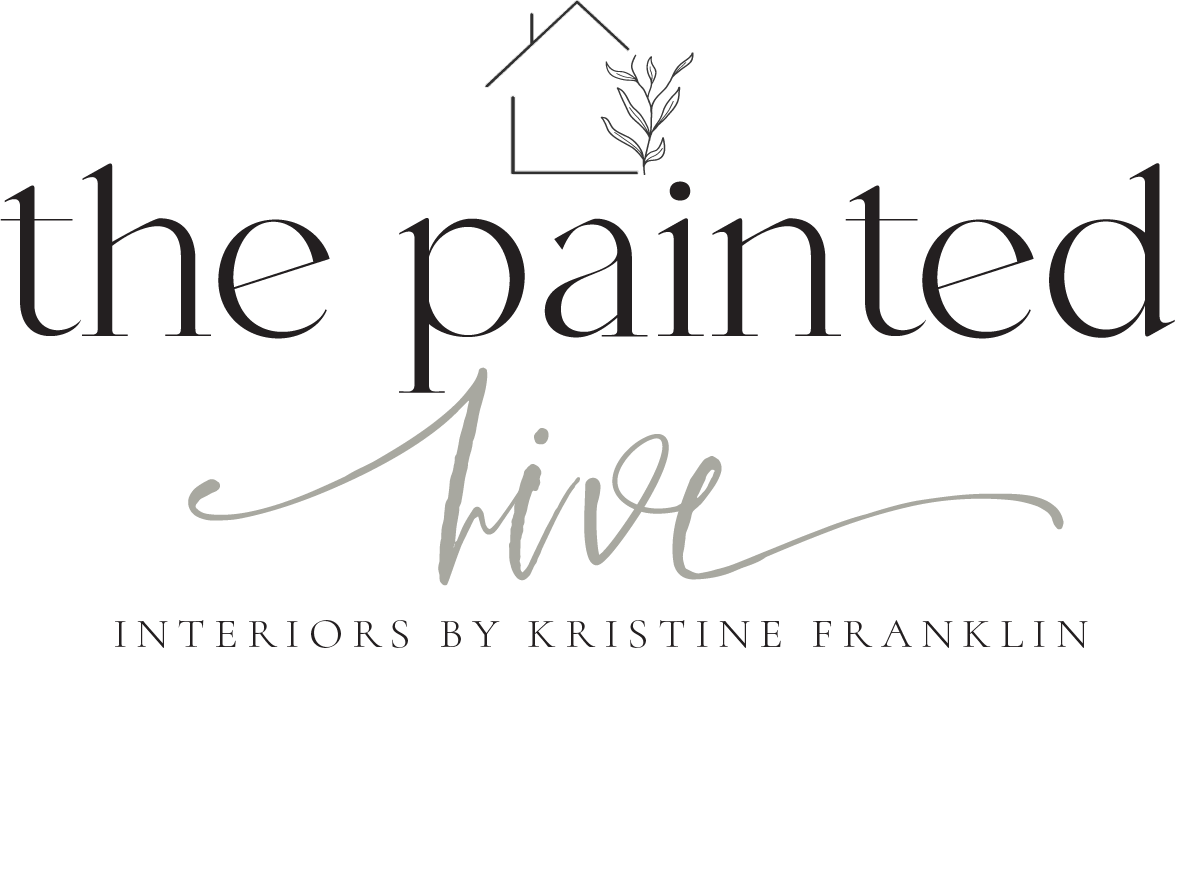
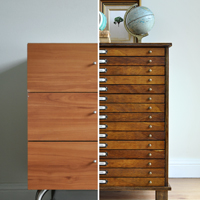
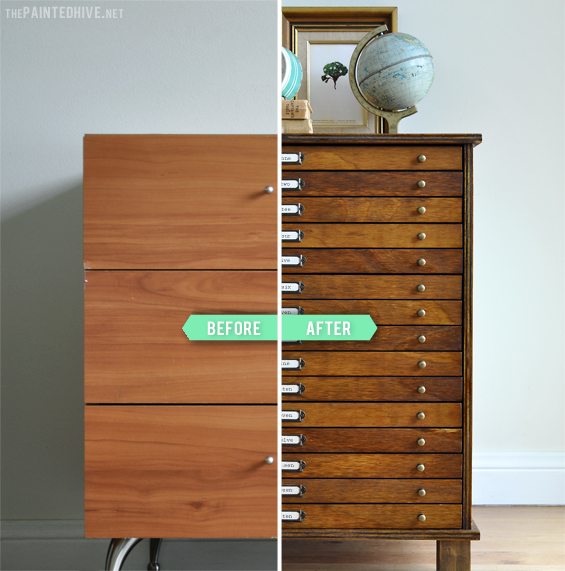



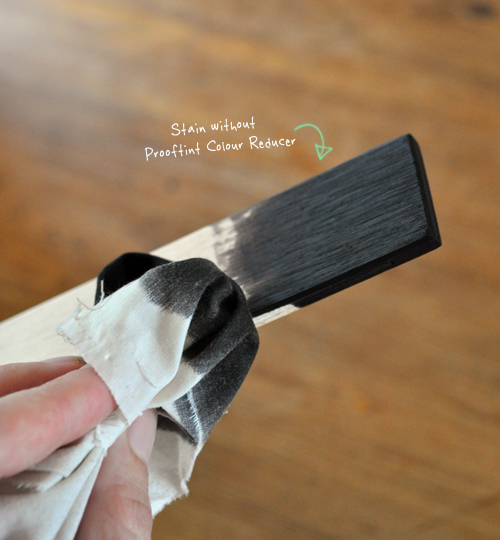
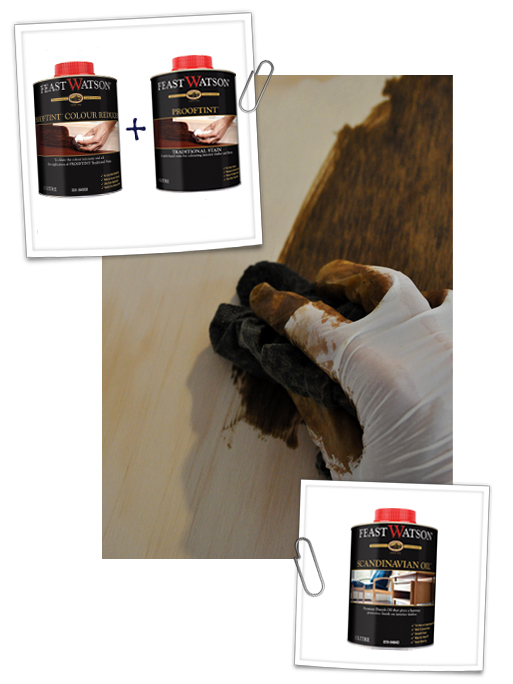



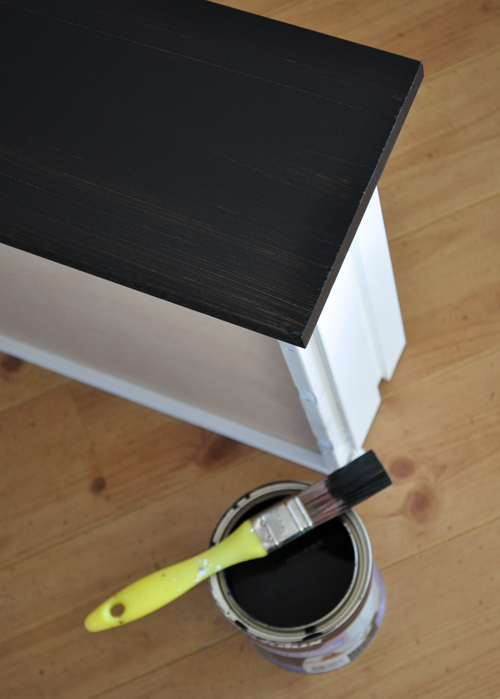
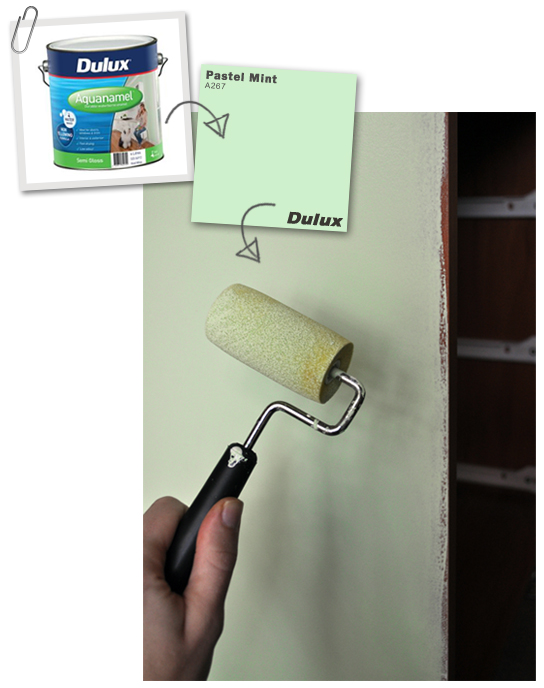

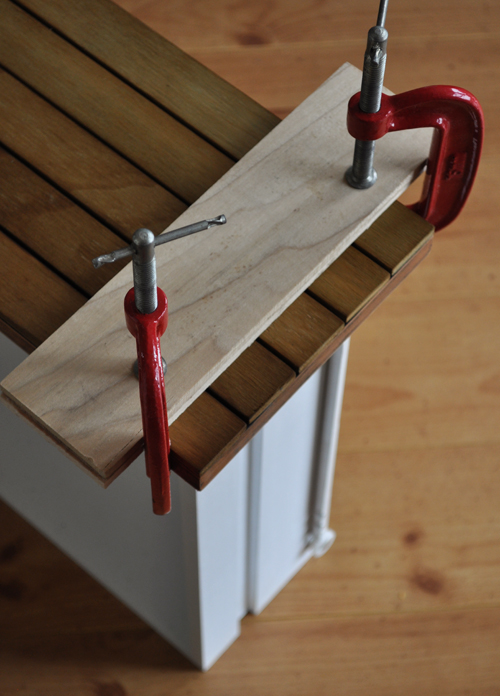
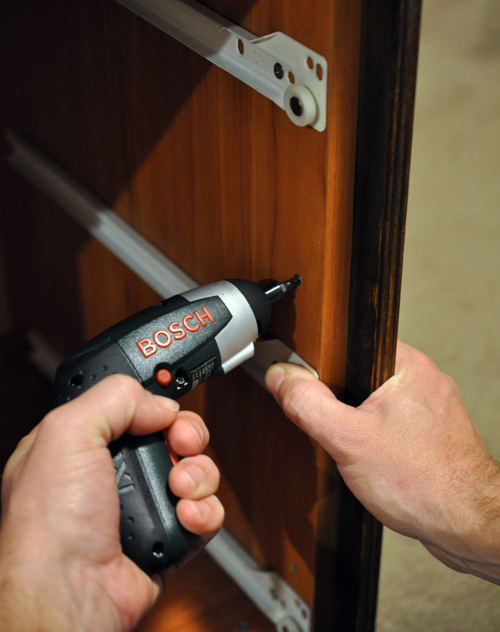
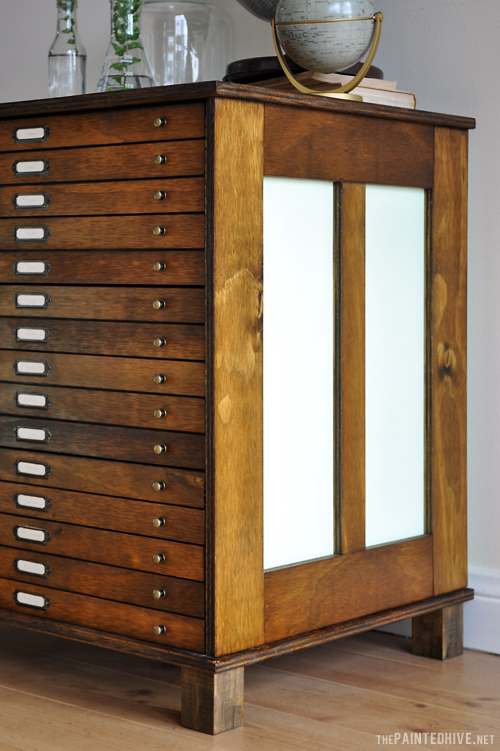

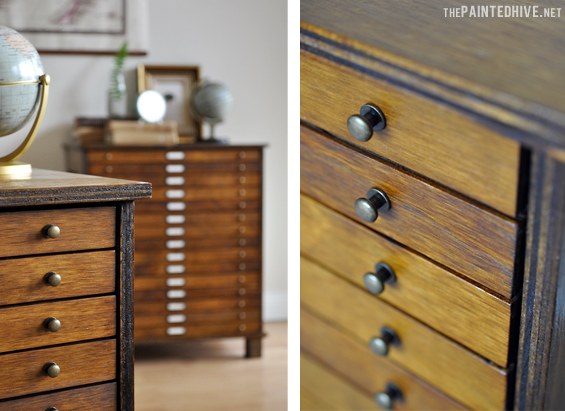
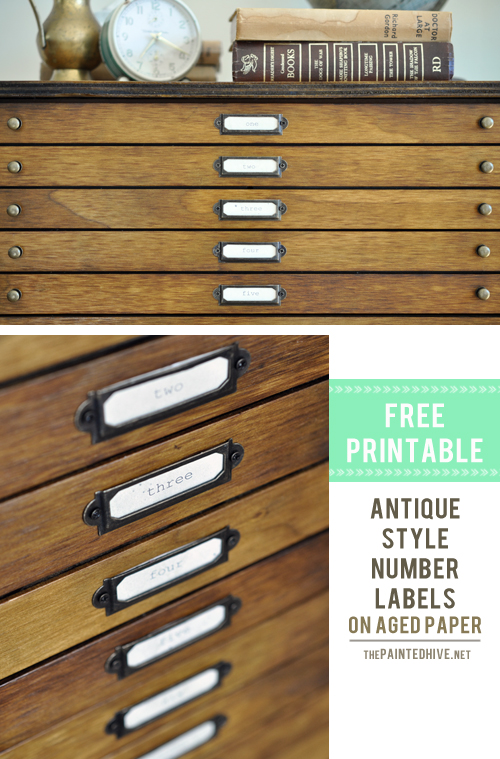
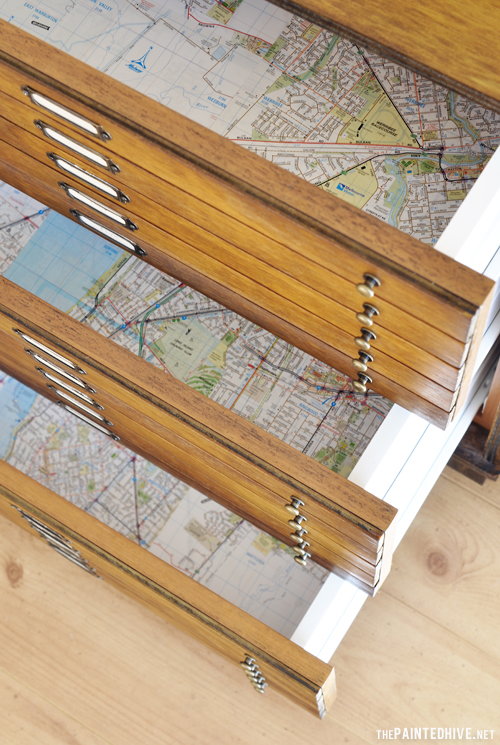
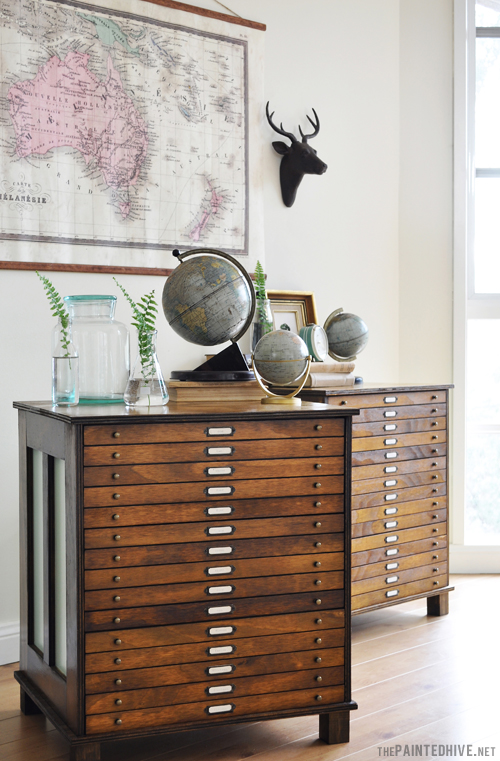
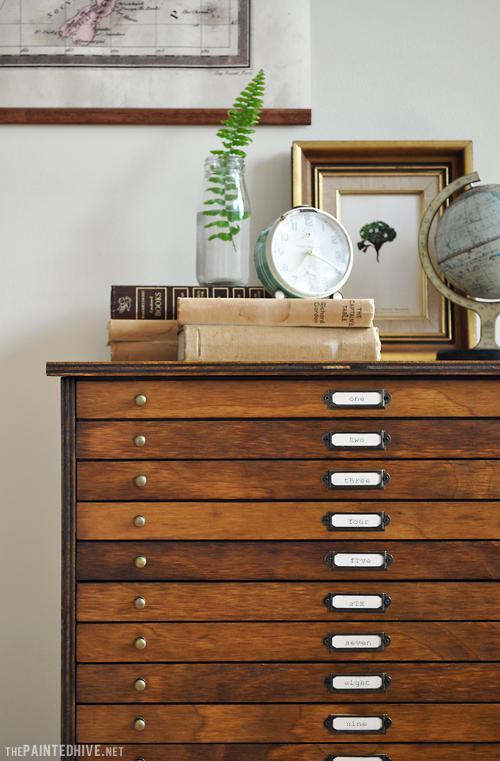
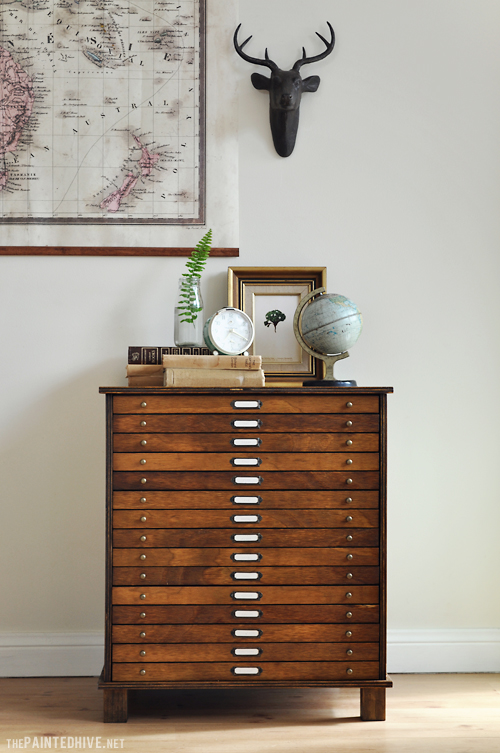
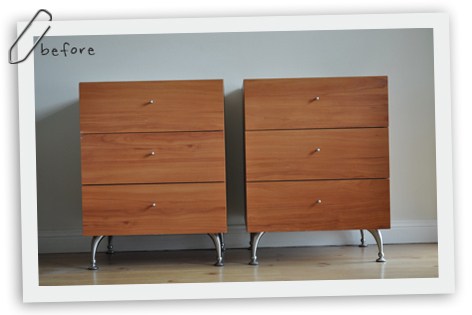
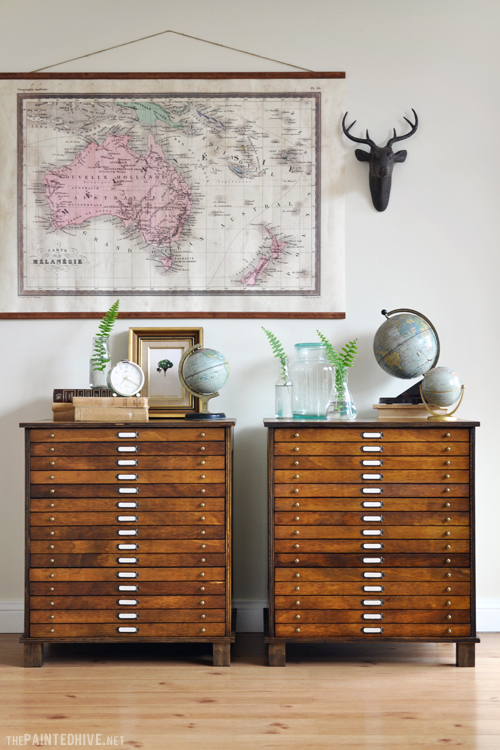
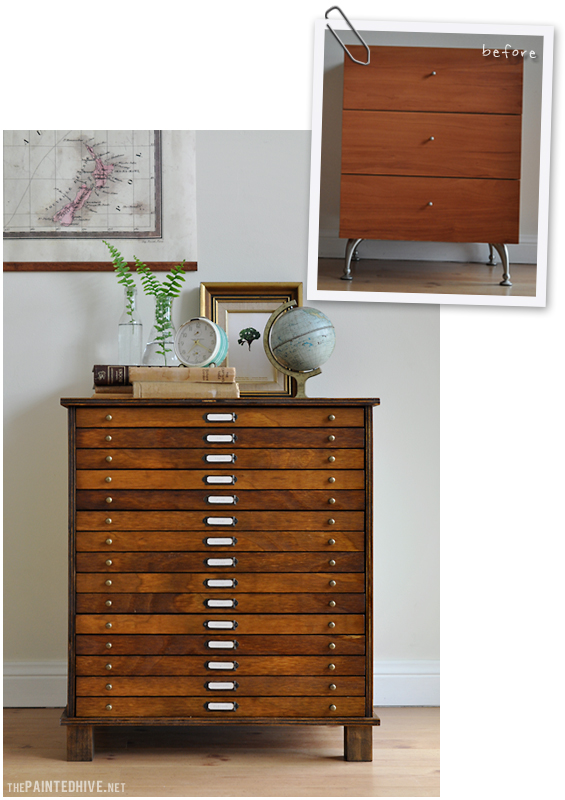
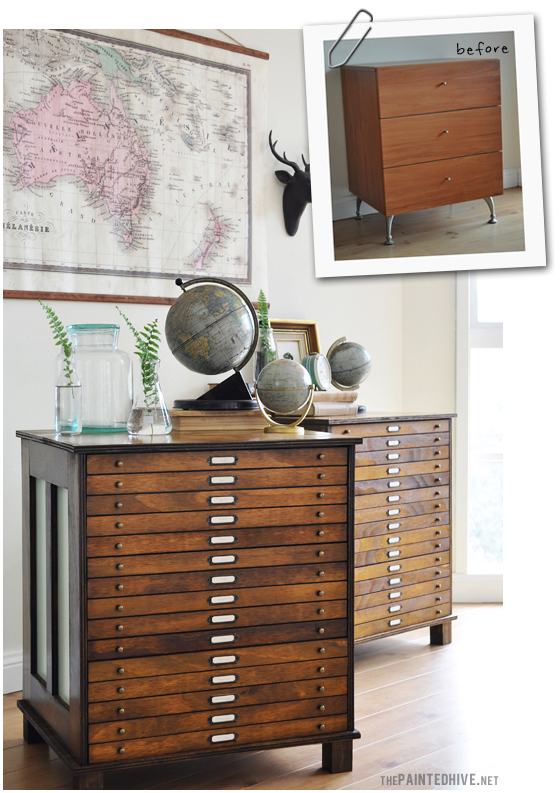

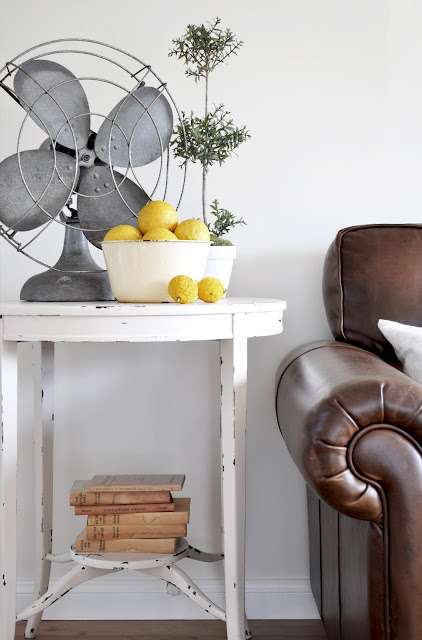
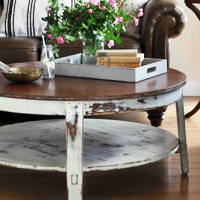
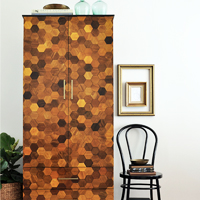
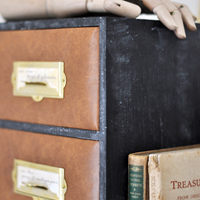

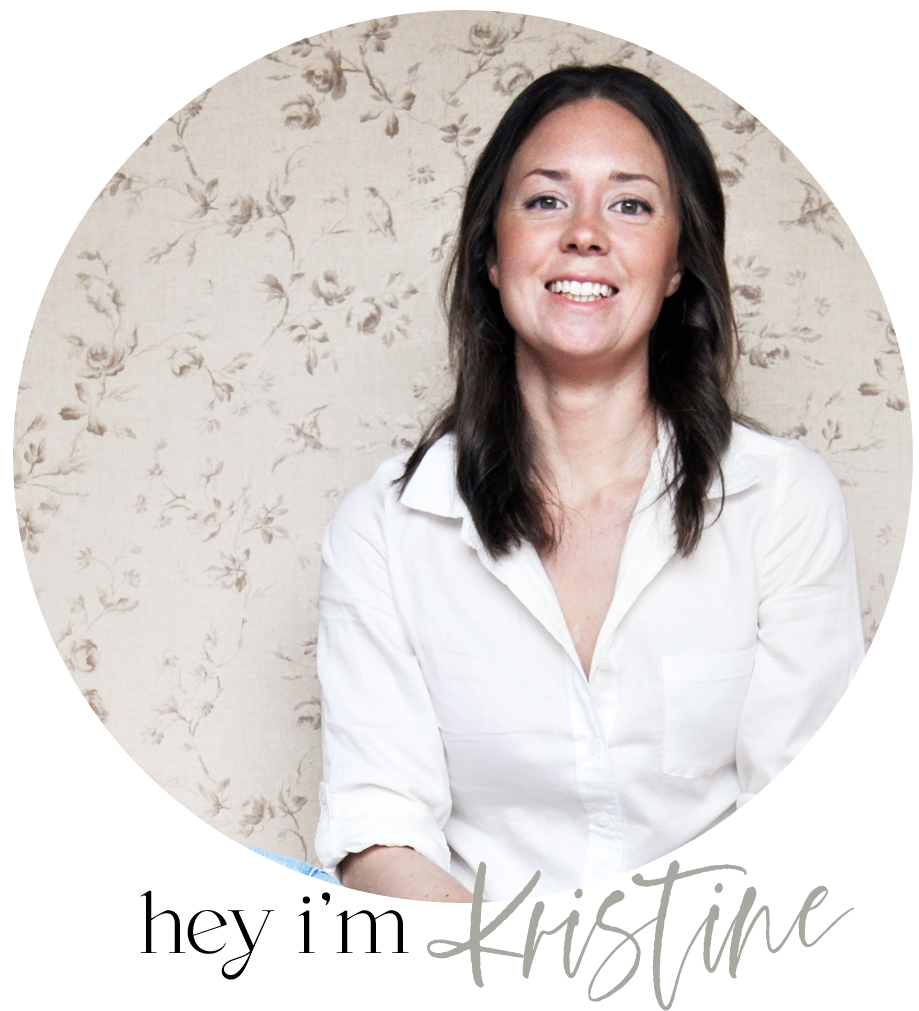

These are amazing, I’m so impressed! I was wondering if you used little spacers between the cladding pieces on the front of the drawers when you attached them to give the impression of separate drawers?
Hi Clare
Thanks!
I thought about this though found it easy enough to simply align the cladding by eye, making sure there was a slight (and even) gap between each piece. The important factor is allowing for the gap (not too big, not too small) when measuring and cutting the cladding in the first place.
Kristine
Classical finished, awesome inspiration, thank you for great post.
This is just wonderful – I love old map drawers and you’ve created a gorgeous pair, from such an ugly duckling start – beautiful work, I know their next owners will really love them too ;)
Thank you so much for answering my questions about the track saw. I am currently doing research and going to definitely buy one. I had never heard of them before and they seem “safer” to me than a table saw. They have actually been around for quite a while. Don’t know how I missed them!
I think they probably are a lot safer than a table saw. To be honest, I didn’t know they existed either until we started looking into buying something that could cut straight lines. They are pretty cool.
Just found you! Don’t know why it’s taken so long. Love your work and those cabinets,,,,brilliant! Truly ingenious. I’m always looking for different designs and techniques to try out. Making a platform bed w/an artsy headboard at the moment. Pop by and peruse my Gallery if you get the chance!
Hi, Amazing! I’d love to do this project. Is it a table saw you used? Is it easy to cut such small pieces of timber? I just have to give this a try.
Hi Tatem
We used a plunge track saw. It’s a great tool and makes cutting lengths of timber, even quite narrow ones, really easy – and the results are perfect!
This is sooo genius! You should be super proud! Excellent execution & lovely results. Bravo!
These are just the best.
LOVE this! Amazing transformation. Inside and out. And to think it is going towards proceeds is truly over the top. You ROCK!
~so sharing this~
Thanks Robin :-)
I am in shock that these incredible pieces started out that way! I am in awe and in love!
Deb
@Seeking Lavender Lane
WOW, this is the most amazing furniture makeover I’ve ever seen. When I first saw the before and after pictures, I couldn’t believe that this is the same piece of furniture. Fantastic job!!!
Julia
Inspirational. So well done. I’m very glad your drawers have lead me to the treasure trove that is your website.
Thanks so much Johanne.
This is truly an amazing transformation! It looks like it belongs in a high end furniture store! Shared on my facebook page and pinning now!
Ah.maz.ing. job!! you have incredible vision! Thank you so much for posting this. I wish you success with your auction
You are so talented and creative!
Saw this when you first posted and now on MMS. I don’t remember if I commented so I just have to say these are amazing. You’ve turned junk into treasure. Lots of people can slap on a coat of paint, you totally created something new. Bravo
Thanks so much Erin.
This is probably the best furniture makeover I have ever seen! Amazing Kristine! Only slightly in love with the fact that you accented them with mint. My fave!
Mint rocks! I’m a neutral girl at heart though am soooo tempted to paint my kitchen cabinets mint one day.
Loved the concept thanks for sharing it helps me to explore the concept in a better way
WOW!!!!
Kristine you did an awesome job, what a clever transformation.
You Are INCREDIBLE, girl! I’ve been a long time follower of your blog and you just blow me away with your ideas and talent. This is amazing!! (I have even listed on my blog as one of my fave blogs). You’re amazing, love this!!
Hugs,
Jamie
Thank you so much Jamie. I love following your projects too and adore your style. A neutral girl like me with hints of subtle pattern and natural elements :-)
Beautiful! Just beautiful!
Wow! You totally had me fooled. I thought for sure those were antiques. Wonderful job!! xo
This is a wonderful makover! very inspiring!
Crazy, wonderful, AMAZING! I’m completely in awe…and now looking for drawers to make some of my own! Well done!
Awesome. It’s so enriching to inspire people. Yay!
You have the most amazing furniture hacks. And I love the in depth tutorials! I always enjoy reading the entire tutorial, even I think I may never attempt such a thing. What a great upgrade. I hope they go for lots of money. Definitely will be sharing on my FB page.
Dear Kristine we are always in awe of your transformations but this time you have really excelled yourself. These are truly amazing. And to top it off for a good cause. Big congrats to you and your apprentice! Love D & M
Thanks so much Deb. It’s really lovely to get a little message from you.
xoxo
These are absolutely amazing!!! No doubt you will have a sad goodbye for these beauties!!! Your tutorial is AMAZING as well, and absolutely made me feel empowered to create a project like this – such a professional result!! your choices in using plywood (I also love exposed ply) stain color/finish, drawer pulls, and leg style give this piece a very high end finished look! thanks for taking the time to share the tutorial!!!
OHMYGOODNESS! Saw this featured on MMS’s blog. TOTALLY awesome! LOVE them so much!
This is over the top amazingly awesome!!! pinned and love!
Hi Kristine,
I used to work with your hubby at MPH, had heard you had started this great blog and always meant to check it out… was just reading one of my fave blogs ‘Centsational Girl’ and saw the link to this awesome project! Good on you, exciting times! Hope you and the family are well!
Jo :)
Thanks for stopping by Jo. Of course, I remember you well! Had no idea you had started your own organising business – that’s awesome!
This blog is still just a hobby of mine at the mo’ though am hoping to grow it once the kids are a little older.
Too funny hearing from you now. Just had a random comment from Julie Welsh last week who didn’t realise who I was. It’s a small world!
Hope your little family is doing well too :-)
Discovered you thru Pinterest. What you did with those nightstand drawers was genius!!! I love mixing old and new. Also using this project for a charity is very cool. You get 5 Gold Stars for this one! I look forward to checking out the rest of your blog/site and see what else you’ve done. Thank-you for sharing these great ideas with the rest of us! Keep up the good work!
I do not remember the last time I was this inspired by a project. AMAZING new look – I am so excited to copy this!!!
Thanks for sharing your awesome idea!
Amazing transformation Kristine! Very clever lady, thanks for all the thorough instructions, one day I would love to have a go at making my own map draws.
This is the most inventive and accomplished make over I have ever seen and I have seen a few. Well done.
Wow, thanks Tricia.
Fantastic job Kristine. You have an amazing talent and you have inspired me to get cracking on a new project. The explanation of how you achieved the make over was easy for even me to follow.
Thank you and good luck with your career.
Thanks so much Jim.
Good luck with your project and enjoy it.
Absolute genius!
Absolutely stunning! Well done!! Random question, where did you find the map on the wall behind the pieces. I lived in Australia and moved to the states and am ALWAYS on the lookout for beautiful maps of australia. thanks! x
Hi Chelsea
That is actually just a reproduction poster I picked up for $10! I attached some stained dowel and a hanging string to make it look like an antique wall chart.
I bought it a few years ago and just checked the store’s website though it looks like they don’t have them anymore. If you do a Google search for “Antique Map of Australia” or “Vintage Map of Australia Poster” etc. I think you should find some reasonably priced ones.
Kristine
Hi Kristine,
I love this refacing. I am considering refacing my blah laminent kitchen cabinets using this technique. I think it looks great on a single piece but am concerned it may be too busy in a kitchen. At the same time, it may give a feel in my galley kitchen of walking through an ancient hall of maps:) I value your opinion as you have an eye for visualization.
Big fan! Thank you for this website!
Hi Ryan
I agree there is potential for it to look AMAZING though also the possibility it might be a little too busy. I guess it all depends on how many cabinets you have, the general configuration and the overall size of your kitchen. Are you planning on cladding everything (cabinet doors, drawers and overheads)? Or just a portion? Also, keep in mind that any facing you add will increase the depth of your doors so make sure they can still swing open okay. You could always do a cardboard trial to give you an impression of the overall feel. If you like, feel free to forward me a photo :-)
Kristine
Amazing!!! One of the best transformations I have ever seen!
Absolutely stunning Kristine!!!! Gorgeous, LOVE YOUR WORK!!!!! xx Rani
Thanks so much Rani.
xoxo
Hey Kristine,
These are beautiful-would it be possible to buy one from you still?
Hi Alyssa
Thanks so much.
Unfortunately, this pair is now sold however I am open to the possibility of custom creating more. That said, I believe you may be located in the US? I’m in Australia.
Kristine
Hats off! You did an outstanding, “labor of love” job on these tables. I personally am a modern/contemporary guy, so saw lots of promise in the “before” pieces, but after reading your purpose and understanding your direction, I think you totally “nailed it.” (Bad pun, sorry!) I’m always working on projects here and there, and have several inexpensive laminate pieces in my attic that I hope to update with cladding (inevitably leftover from other projects – my life is one big project! – and stored in my garage) and you certainly have inspired me. Great job!
Thanks Robby. It’s really refreshing to hear that although we mightn’t share the same taste you can still understand and appreciate the project. The original laminate finish was actually pretty chipped (hard to see in the before shots – I should have taken some close-up pics) so they seemed like perfect candidates for the cladding treatment.
These are absolutely beautiful. Great job!
In this case, I just have to ask: Why didn’t you just build new cabinets yourself instead of doing all this extra work? You have all the tools and know-how! JEESH!!!!
I thought some people might wonder this which is why I mentioned my reasons in the post.
The fact is, aside from a wonky coffee table I made years ago, I’ve never built anything from scratch (probably as a result of said wonky table).
Starting with these structurally sound pieces actually saved me a heap of extra work, not to mention brain-power, time and probably cash too. It was also rewarding to take something destined for the rubbish dump and give it a new lease on life.
Also, I like to share projects others feel they can probably accomplish. Building furniture from scratch is beyond a lot of people (both in terms of ability and desire). I think the idea of attaching some cladding is more appealing to regular DIY’ers. I know it is to me.
Building from scratch would not eliminate any of the work that had to be done. It would just have added more work. This is a perfect solution for something that was going to be thrown away.
Not to mention it was sold for charity (kudos on that) and the premise of the whole campaign was to upcycle an existing piece.
WOW. Amazing — gorgeous — SO impressed. And inspired too — to try something like this project one day!!
These are awesome, what a change! Well done. :)
WOW!!! You are incredible! This brought the memory of my dad’s type cases in his typography shop, my first real job. I have kicked myself for not having asked for some of the cabinets when he resolved his business. Now I am inspired to create my own! I am in between projects so this certainly will be my next one. I love your site and can’t wait to see the direction you will go in upcoming holiday season.
I didn’t realise these were like type cases until people started commenting. I just thought I was replicating map drawers (on a mini scale) because I couldn’t think what else would have been housed in such skinny drawers (aside from documents). So glad to have jogged some lovely memories and helped inspire your next project Kathy.
I love this, you have done such an amazing job! what an inspiring project!
Wow. These are stunning! I am totally inspired by this project! I can’t wait to explore the rest of your blog!
Thanks Lauren.
This is an amazing idea, and tutorial. I’ve been really lusting over the old card catalogs, and think that this idea could be interpreted to make faux-fronts for a similar type of imitation. My husband loves old maps, he will think this is a really neat project.
Honestly – I loved this whole thing – but my favorite part was your picture at the end. For some reason, I thought these tables were more like dressers, and I missed that you said “bedside”, so when I saw you sitting on this miniature thing at the end… it was so hysterical to me! I could have sworn they were huge, and then you’re sitting on this tiny thing at the end. I busted up.
:)
He, he. Glad to give you a chuckle ;-)